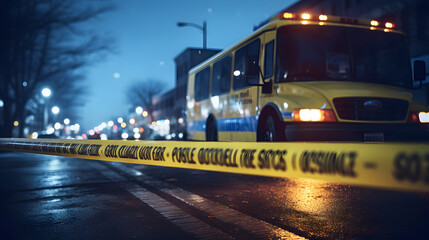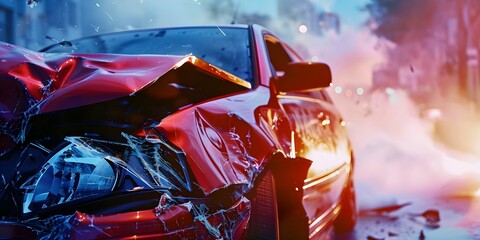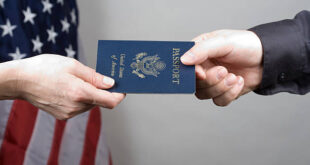If you’re involved in a traffic accident in New York, your life can change drastically. You could face injuries, damage to your vehicle, and the task of dealing with complex insurance forms for medical and repair services. Additionally, other drivers may sue you, claiming you were at fault for the accident.

First step: What to do if you’re involved in an accident
Every year, thousands of drivers in New York are involved in traffic accidents. In 2022, nearly half a million such incidents occurred on the state’s roads. These accidents range from minor fender benders to fatal collisions. It’s no surprise that New York City has the highest rates of fatal accidents per mile in the state, according to data from the National Highway Traffic Safety Administration (NHTSA).
- If you find yourself in a traffic accident in New York, regardless of fault, there are certain steps you should take to protect yourself and reduce your liability.
- Stop: It’s mandatory to stop at the accident scene. Leaving the scene when there’s property damage is a traffic violation, and if there are injuries or fatalities, it’s a criminal offense. Being in an accident can be terrifying, but fleeing can lead to jail time.
- Call the police: If there are injuries, you must call the police, even if the other driver asks you not to. You should also do so if there’s damage to other people’s property (like a parked car) or if certain types of domestic animals are injured.
- Exchange information: Share your contact and insurance information with the other driver, the police, and anyone else involved. Provide your name, address, driver’s license number, and insurance information. The police will also need your vehicle registration.
- Take photos of the accident scene: If it’s safe to do so, take photos of the accident scene. Capture images of the other vehicle, its license plate, and how the cars collided. If possible, photograph the road, showing the surface, lighting, obstacles, etc.
- Get witness information: If there are witnesses, try to get their names and contact information. Witnesses are often reluctant to provide information, but even getting their first names can help your lawyer locate them later. If there are passengers in the other vehicle, try to get their names as well.
If someone is injured, don’t move them unless they are in danger. If safe, move your vehicle off the road and mark the area with flares or reflectors. Be cautious of potential fuel leaks or other fluids.

Things not to do at the accident scene:
Don’t leave the scene: Fleeing the scene of an accident is a serious crime. Even if there are no injuries, you could face jail time. If there are injuries or fatalities, you could face up to seven years in prison. Additionally, your insurance rates may increase, and you could lose your license.
Don’t admit fault: It’s natural to want to say «sorry» when something goes wrong, but avoid doing so. Don’t offer to pay anything, accept splitting costs, or let the other person cover your deductible.
Don’t argue with the other driver: Road rage is increasingly present in traffic accidents. If the other driver starts arguing, yelling, or showing weapons, return to your car or find a safe place and wait for the police.
Don’t leave until authorized by the police: Before leaving, obtain the police incident number as you’ll need it for your insurance claim. Also, get the name and badge number of the attending officer.
Second step: Immediately after the accident
It’s advisable to visit a doctor after an accident. Even if you believe you haven’t been injured, go to the emergency room for a check-up. After an accident, you may be in shock and not feel back or neck pain until the next day. Additionally, certain types of head trauma can take hours or days to manifest. A doctor can advise you on which symptoms to watch for.
Your insurer may require a medical examination if you file a claim. An immediate examination after the accident provides a reference for assessing future injuries. Keep all medical reports and doctors’ notes and follow post-care instructions.
In New York, you must file a report with the DMV within ten (10) days of the accident if property damage exceeds $1,000 or if there are injuries or fatalities. Use form MV-104, available online. Failure to file the report may result in your license being suspended.
Don’t assume the other driver will file the report. It’s safer to file it yourself.

How to obtain your police report
You can obtain a copy of your accident report from the police department that responded to the incident or from the DMV. If the New York police handled your accident, the report will be available at the precinct office for 30 days after the accident.
Other departments and the state police have online portals for accessing your report. After 30 days, all accident reports can be obtained through the New York DMV. You’ll need form MV-198C, available on the DMV website.
It’s essential to obtain a copy of the accident report from the local police agency or the Department of Motor Vehicles. This report will be necessary for your insurance claim.
You should contact your insurance agent as soon as possible after the accident. Depending on your insurance company, you may have up to 30 days to file your claim, but don’t delay. Even with New York’s no-fault insurance, you must prepare your documents and initiate your insurance claim immediately. No-fault insurance only covers part of your damages. To receive full compensation you’re entitled to, you must prove the other driver was at fault.
At this point, you may need the services of a lawyer like Morgan & Morgan. Whether you want to file a claim with your own insurer or against the other driver, you’ll need the help of a personal injury lawyer. Your legal team will help you build your case and ensure you have everything you need when filing your claim.

Third step: Initiating the claims process
New York has a mandatory no-fault insurance law that covers up to $50,000 in benefits for medical expenses, lost wages, and other monetary costs for anyone injured in a traffic accident. This coverage only applies if you weren’t under the influence of alcohol, incapacitated, or involved in criminal activity (like fleeing the scene).
No-fault insurance doesn’t cover compensatory damages like pain and suffering. To obtain that compensation, you must prove the other driver was at fault and seek compensation through the court.
There are strict deadlines for filing a no-fault insurance claim. Having a legal team can be very helpful to ensure you don’t miss these deadlines.
No-fault claims: Must be filed within 30 days after the accident. Your initial forms must be submitted by that date at the latest.
Medical claims: Must be filed within 45 days after treatment. You can pay your doctor and then request reimbursement from the insurer, or your doctor can send the bills directly to the insurer. Inform the provider that the treatment is related to a traffic accident.
Lost wages and other expense claims: Must be filed within 90 days after the date of loss. For example, if you miss a week of work due to the accident, you must file your claim no later than 90 days after that week.
No-fault insurance covers drivers, passengers, pedestrians, and other injured parties in traffic accidents caused by the «use or operation» of an insured vehicle. If you have any doubts, contact your insurer or lawyer.
Fault and comparative negligence
If you decide to sue the other driver, you need to understand how negligence and fault are proven in New York. As it’s a «no-fault» state, you can recover damages without proving the other driver’s liability. However, to recover for pain, suffering, or other damages beyond the «no-fault» limit, you must prove fault.
Negligence is a legal theory that determines a person’s responsibility for causing an accident. To prove negligence, your lawyer must show that the other person:
- Had a duty (responsibility)
- Breached that duty
- That breach caused harm
- You suffered actual harm due to the breach
In traffic accidents, we all have a duty to drive safely. Failing to do so is a breach of that duty. However, rarely is anyone 100% at fault in an accident. For example, the other driver may have run a red light, but you may have stopped in the wrong place at the intersection. Shared fault is how insurance companies determine who pays for an accident.
New York uses pure comparative negligence to determine fault. Under this rule, the amount you can recover is reduced based on your percentage of fault. If you’re 10% at fault, you can recover 90% of your damages. Theoretically, you could be 99% at fault and still recover 1% of your damages.
Some states use modified comparative negligence, where if a driver is 50% or 51% at fault (depending on the state), they cannot recover in their claim. Three states still use contributory negligence, where if the plaintiff has even 1% fault, they cannot recover any compensation.

Estimations and repairs
Take your car to an auto repair shop as soon as possible after the accident. Your insurance company may suggest a shop, but they cannot force you to go to a specific one. Once you select a shop, inform your insurer so they can send their appraiser.
The appraiser will assess your car to determine if it’s worth repairing. If the cost of repairs plus salvage value (the value of parts and scrap from the car) exceeds 75% of the cash value of the car, the appraiser will declare it a «total loss.» Insurers assume that if a car is severely damaged visibly, there will be more hidden damages that will emerge during repairs.
If you disagree with the appraiser’s damage assessment, you can request a «total loss appraisal.» This assessment is conducted by a professional appraiser who can more accurately

 Employeer and business Information about Employeers, plataforms and works
Employeer and business Information about Employeers, plataforms and works 



